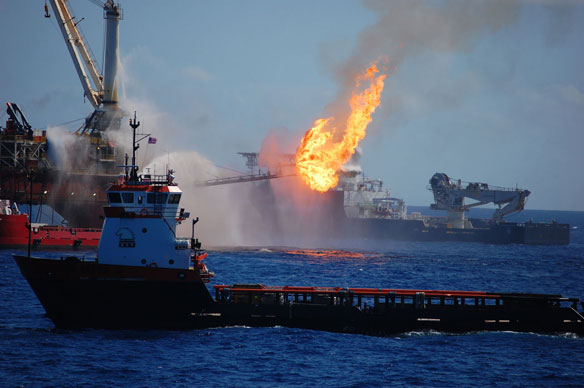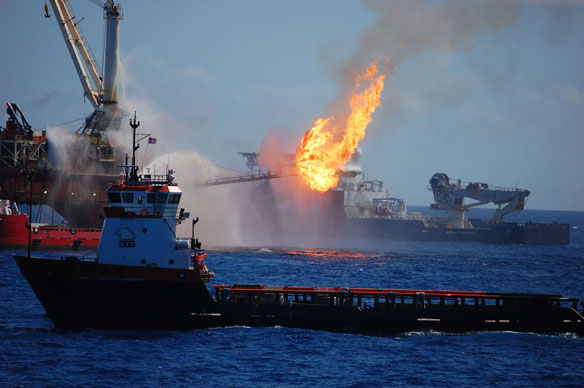
Photo source: NOAA
By NOAA
The amount of air pollutants in the atmospheric plume generated by the Deepwater Horizon oil spill was similar to a large city according to a new NOAA-led study published in a special issue of Proceedings of the National Academy of Sciences.
Researchers from the NOAA Earth System Research Laboratory (ESRL) and NOAA’s Cooperative Institute for Research in Environmental Sciences (CIRES) in Boulder, Colo., along with university colleagues, focused on ozone and particulate matter—two pollutants with human health effects.
About eight percent, or about one of every 13 barrels of the Deepwater Horizon-spilled oil that reached the ocean surface, eventually made its way into airborne organic particles small enough to be inhaled into human lungs, and some of those particles likely reached the Gulf coast when the winds were blowing toward the shore, according to the study.
“We could see the sooty black clouds from the burning oil, but there’s more to this than meets the eye. Our instruments detected a much more massive atmospheric plume of almost invisible small organic particles and pollutant gases downwind of the oil spill site,” said Ann M. Middlebrook, scientist at NOAA ESRL’s Chemical Sciences Division (CSD) and lead author of the study.
According to the study, over the course of the spill, the total mass of organic particles formed from evaporating surface oil was about ten times bigger than the mass of soot from all the controlled burns. Controlled burns are used to reduce the size of surface oil slicks and minimize impacts of oil on sensitive shoreline ecosystems and marine life.
The organic particles formed in the atmosphere from hydrocarbons that were released as surface oil evaporated, and they got bigger as they traveled in the plume. The atmospheric plume was about 30 kilometers wide– about 18.5 miles – when it reached the coast.
Some of the hydrocarbons from the evaporating oil reacted with nitrogen oxides in the atmosphere to create ozone pollution, but this other atmospheric plume was only 3 to 4 kilometers (2 to 3 miles) wide at the coast.
“The levels of ozone were similar to what occurs in large urban areas. During the oil spill, it was like having a large city’s worth of pollution appear out in the middle of the Gulf of Mexico,” said Daniel M. Murphy, NOAA scientist at ESRL/CSD and a co-author of the study.
The relatively small amounts of nitrogen oxides in the vicinity of the oil spill (which included nitrogen oxides emitted by the spill cleanup and recovery efforts) limited the amount of polluting ozone that was formed offshore. When the excess hydrocarbons reached the coast, they could have reacted with on-shore sources of nitrogen oxides, such as cars and power plants, to form additional ozone.
The researchers gathered data in June 2010 on two flights of NOAA’s WP-3D research aircraft that was outfitted to be a “flying chemical laboratory.” They also analyzed data gathered on ships in the vicinity and at two monitoring sites in Mississippi downwind of the oil spill.
They used a regional air quality model to project the path of the particle pollution, and found that time periods when the pollution plume was predicted to have reached the coast matched up well with a few short periods of high readings at the monitoring sites.
In addition to the organic particles that formed from the evaporating oil, soot particles were lofted into the atmosphere from the oil that was burned on the surface.
The authors note that their findings could help air quality managers anticipate the effects of future oil spills. The depth of the Deepwater Horizon spill, about a mile beneath the surface, limited the effects on air quality because some hydrocarbons, such as benzene, largely dissolved in the water.
“It was fortunate that the effects on air quality of the Deepwater Horizon oil spill were limited in scope,” said Middlebrook. “Our findings show that an oil spill closer to populated areas, or in shallower waters, could have a larger effect.”









